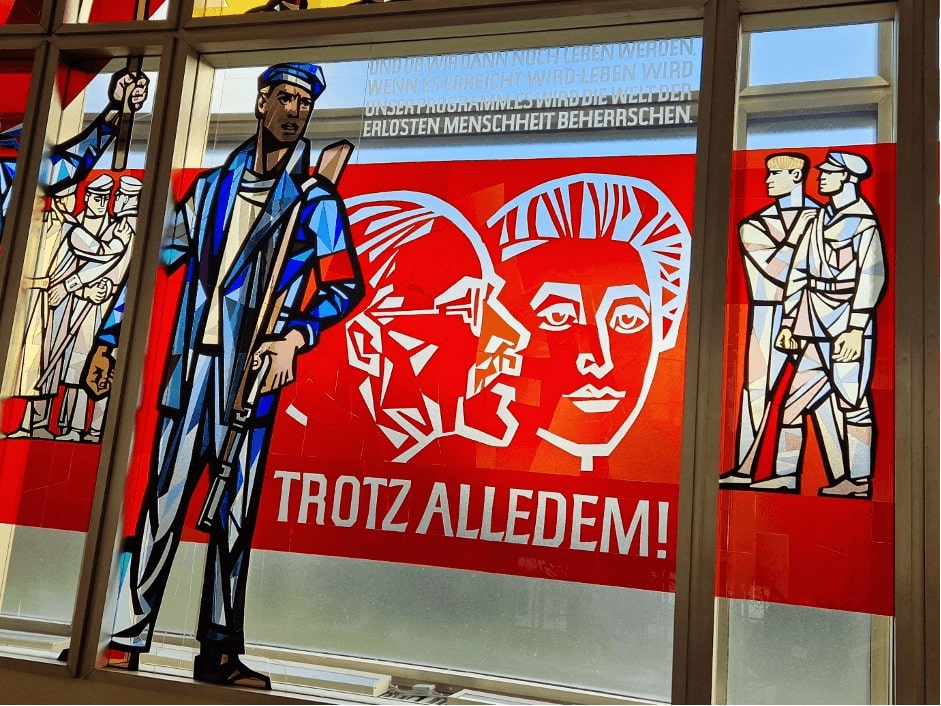“Out with the old, in with the new.” That was the title of the 2023 Academic Publishing in Europe conference (APE2023), which promised fresh discussions on the future of open research publishing. The event was held from 10-11 January at premier German business school ESMT, in the historical setting of the former East-German State Council Building (Staatsratsgebäude). The venue’s vertiginous ceilings spoke to the grandeur that our industry is aiming to reach by focusing on equity, openness and the smooth exchange of information.
‘Impossible’ is not a concept that concerns fiction writers
Günter Ziegler, President of Freie Universität Berlin
One of the ESMT building’s most striking features was a stained-glass window celebrating the resilience of East Germany’s workers. Alongside images glorifying industry and Mother Nature’s bounty, the glass bore the political slogan, “Trotz Alledem” (“In spite of everything”). We had all come together to tackle challenges in our field, so this seemed fitting. But was the scholarly publishing industry ready to embrace innovation and support its authors?
This question featured during many panel discussions on the first day, but it was the attendees, rather than the speakers, who had the clearest view of innovation and its integration (or lack of) among scholarly publishers. APE is an unusual conference in this field; it has always made room for innovative newcomers and fresh ideas, most notably through its Award for Innovation in Scholarly Communication.
This year’s attendees included more cutting-edge companies and representatives of publishers recently acquired by global brands. These included Knowledge Unlatched and Hindawi (now part of Wiley) and Charlesworth (now part of Enago). Having gone through the takeover process, these representatives brought expertise on the value of acquired innovation to larger established brands.
Innovation comes in many guises. Other attendees included Berlin-headquartered companies ResearchGate and Morressier and US company Silverchair, all of whom had won substantial financial backing to develop cross-industry solutions. Meanwhile, those in the long tail of innovation (such as your humble correspondent for SciencePOD) shared insights on niche science publishing solutions during networking sessions. Among the notable entrepreneurs in attendance included the representatives of scite.ai, Audemic.io, hum.works and Prophy.science (the latter winning the aforementioned award).
This diverse audience’s combined wisdom on the ideal conditions for innovation makes APE2023 one of the best networking events in the industry. But we could diversify even further, and gain even more valuable knowledge by reaching out to the tech industry. Our industry needs to stay up-to-date on the latest tools and processes available to improve our products, integrating third-party solutions for the best results.
One of the key takeaways from this year’s conference was the need for connection and facilitation, with more people focused on improving access to information and to key decision makers. There are promising signs, though. Harsh Jegadeesan, a former senior executive in the tech industry, has taken on the newly-created role of Chief Solution Officer at Springer Nature.
Technology, technology, technology
Throughout the conference, the audience were captivated by discussions on the role technology could play in furthering the open access and FAIR Data agenda. But preaching to the converted only gets you so far, and it remains to be seen what hurdles emerge at the implementation stage.
There is no shortage of emerging innovations aimed at the scholarly publishing industry, but the solutions presented are often piecemeal. To established publishers, incremental solutions fail to address the issues of quality control, and a general need to upgrade traditional processes.
One speaker, Philip Koellinger, proposed tools and ideas for broader systemic change. He suggested a move toward decentralised distributed content management for science publishing, and addressed the limitations of DOIs, recommending their replacement with decentralised persistent identifiers for linked digital objects (dPIDs). Koellinger is President of the the DeSci Foundation, an independent think-tank exploring the potential impact of web3 technologies on the scientific ecosystem.
Such cross-industry solutions are a long way off being adopted by the industry. Koellinger’s vision would require a decentralised meta-library for interoperable research outputs (of any kind); this would need minimal maintenance and little to no dependence on intermediaries. Although this initiative seeks to exploit current technology, the audience remained largely unconvinced: some commented on Twitter that technical issues and managing user behaviour would add further challenges. Others pointed out that for such changes to happen it was “equally important to examine the social dynamics, competitive environment, and investment requirements that drive & impede innovation & infrastructure.”
In reality, our industry relies on a patchwork of legacy IT systems, frequently misaligned with mainstream tech tools, as individual scholarly publishers progress slowly through their digital transformation.
Any large upgrade to newer technology solutions will take a very long time, and we need to know that investment of time and money will be worthwhile. Meanwhile, improvements from the long tail of incremental innovation could help our industry to sample the potential of newer technologies to see their impact
Ending on a positive note, Günter Ziegler, President of Freie Universität Berlin, closed the conference on the first day. He reminded the audience that ‘impossible’ is not a concept that concerns fiction writers, and that researchers could benefit from this approach.
He demonstrated this point with three examples of technology from classic sci-fi literature: the Babel Fish from Douglas Adam’s Hitch-Hikers’ Guide to the Galaxy, a universal translator (now realised via DeepL), a tool for predicting protein-folding (now available), and 3D heart-mapping (now possible using computerised tomography, though better suited for heart-condition diagnostics than broader human characteristics). At the time of writing the Hitch Hikers’ Guide, none of these inventions existed, and many would have considered them impossible. Each one has since been fully realised, leaving us wondering where tech will take our industry next.

